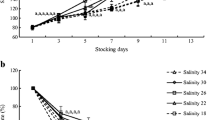Abstract
The purpose of this experiment was to observe the impact of stocking density on growth and food consumption of juvenile Sepia pharaonis reared at 23 and 28°C. Two groups of 32 cuttlefish each were reared in closed recirculating seawater systems with water temperatures of 23°C (group A) and 28°C (group B). Each group was divided into three treatments with two replicates per treatment: low-density (equivalent to 20 cuttlefish m−2), medium-density (equivalent to 100 cuttlefish m−2), and high-density (equivalent to 200 cuttlefish m−2). Measured amounts of live food were added three times a day and the wet body weight of each cuttlefish was measured once a week during the 42-day study. Cuttlefish in group B had higher growth rates and food consumption than cuttlefish in group A. The different stocking densities in group B affected the size of the cuttlefish whereas the stocking densities of the cuttlefish in group A treatments did not lead to different sizes between densities. Overall, the gross growth efficiency of the high-density treatments was lower than that of the low-density treatments, as was the weight of the cuttlefish in the high-density treatment. Although the wet weights of group A treatments were not significantly different (P > 0.05), the wet weights of the cuttlefish in the high-density, group B, treatment were lower than those in the low and medium density treatments. This decrease in individual size suggests that stocking densities of 100 to 200 cuttlefish m−2 may interfere with growth.





Similar content being viewed by others
References
Anil MK, Andrews J, Unnikrishnan C (2005) Growth, behavior, and mating of pharaoh cuttlefish (Sepia pharaonis Ehrenberg) in captivity. Isr J Aquac 57(1):25–31
Aoyama T, Nguyen T (1989) Stock assessment of cuttlefish off the coast of the People’s Democratic Republic of Yemen. J Shimonoseki Univ Fish 37(2.3):61–112
Boal JG, Hylton RA, Gonzalez SA, Hanlon RT (1999) Effects of crowding on the social behavior of cuttlefish (Sepia officinalis). Contemp Top Lab Anim Sci 38(1):49–55
Boletzky SV, Hanlon RT (1983) A review of the laboratory maintenance, rearing and culture of cephalopod molluscs. Mem Natl Mus Vic 44:147–187
Boyle PR (1991) The UFAW handbook on the care and management of cephalopods in the laboratory, vol 19. Universities Federation for Animal Welfare, Potters Bar, pp 35–36 45–46
Chotiyaputta C (1993) Cephalopod resources of Thailand. In: Okutani T, O’Dor RK, Kubodera T (eds) Recent advances in fisheries biology. Tokai University Press, Tokyo, pp 71–80
Correja M, Dominguez PM, Sykes A, Anrade JP (2005) Effects of culture density on growth and broodstock management of the cuttlefish, Sepia officinalis (Linnaeus, 1758). Aquaculture 245(1–4):163–173. doi:10.1016/j.aquaculture.2004.12.017
Dominguez PM, Kingston T, Sykes A, Andrade JP (2001) Growth of young cuttlefish, Sepia officinalis, (Linnaeus 1758) at the upper end of the biological distribution temperature range. Aquac Res 32(11):923–930
Dunning M, Mckinnon S, Lu C, Yeatman J, Cameron D (1994) Demersal cephalopods of the Gulf of Carpentaria, Australia. Aust J Mar Freshw Res 45:351–374. doi:10.1071/MF9940351
Forsythe JW, De Rusha RH, Hanlon RT (1994) Growth, reproduction and life span of Sepia officinalis (Cephalopoda: Mollusca) cultured through seven consecutive generations. J Zool Soc Lond 233:175–192
Forsythe JW, Lee PG, Walsh LS, Clark T (2002) The effects of crowding on growth of the European cuttlefish, Sepia officinalis Linnaeus, 1758 reared at two different temperatures. J Exp Mar Biol Ecol 269:173–185. doi:10.1016/S0022-0981(02)00006-0
Gabr H, Hanlon R, Hanafy M, El-Etreby S (1998) Maturation, fecundity, and seasonality of reproduction of two commercially valuable cuttlefish, Sepia pharaonis and Sepia dollfusi, in the Suez Canal. Fish Res 36:99–115. doi:10.1016/S0165-7836(98)00107-6
Hanlon RT, Forsythe JW (1990) Structural abnormalities and Neoplasia. In: Kinnie O (ed) Diseases of marine animals, vol 3. Biologische Anstalt Helgoland, Hamburg, pp 203–204
Koueta N, Boucaud-Camou E (1999) Food intake and growth in reared early juvenile cuttlefish Sepia officinalis L. (Mollusca Cephalopoda). J Exp Mar Biol Ecol 240:93–109. doi:10.1016/S0022-0981(99)00054-4
Lee PG, Turk PE, Forsythe JW, DiMarco FP (1998) Cephalopod culture: physiological, behavioral and environmental requirements. Suisan Zoshoku 46:417–422
Lin J, Su W (1994) Early phase of fish habitation around a new artificial reef off southwestern Taiwan. Bull Mar Sci 55:1112–1121
Minton JW (2004) The pattern of growth in the early life cycle of individual Sepia pharaonis. Mar Freshw Res 55:415–422. doi:10.1071/MF03204
Minton JW, Walsh LS, Lee PG, Forsythe JW (2001) First multi-generation culture of the tropical cuttlefish Sepia pharaonis Ehrenberg, 1831. Aquac Int 9:375–392. doi:10.1023/A:1020535609516
Nabhitabhata J (1995) Mass culture of cephalopods in Thailand. World Aquac 26:25–29
Nabhitabhata J, Nilaphat P (1999) Life cycle of pharaoh cuttlefish, Sepia pharaonis Ehrenberg, 1831. Phuket Mar Biol Cent Spec Publ 19:25–40
Norman MD, Reid A (2000a) A guide to Squid cuttlefish and octopuses of Australasia. CSIRO Publishing, Collingwood
Norman M, Reid A (2000b) Pharaoh’s cuttlefish, Sepia pharaonis. In: Nottage JD, West RJ, Montgomery SS (eds) A guide to Squid, cuttlefish, and octopuses of Australasia. CSIRO Publishing, Collingwood, p 29
Zar J (1998) Biostatistical analysis. Prentice Hall, New Jersey
Acknowledgments
The authors would like to acknowledge Chrystal Crain and Kristin Shivers for reviewing the manuscript and offering their advice. The authors would also like to thank Mike Andres, Adam Daw, Shannara Collins, Christen Rivera, Gregory Seward, Kristy Spaulding, and the other interns at the National Resource Center for Cephalopods for their help with the feedings. Special thanks to Patricia Edwards for assistance with the statistical analysis. The authors gratefully acknowledge the financial support from the National Institutes of Health, National Center for Research Resources (grant P40 RR01024-30), the Texas Institute of Oceanography, and the Marine Medicine General Budget Account of the Marine Biomedical Institute.
Author information
Authors and Affiliations
Corresponding author
Rights and permissions
About this article
Cite this article
Barord, G.J., Keister, K.N. & Lee, P.G. Determining the effects of stocking density and temperature on growth and food consumption in the pharaoh cuttlefish, Sepia pharaonis, Ehrenberg 1890. Aquacult Int 18, 271–283 (2010). https://doi.org/10.1007/s10499-009-9242-x
Received:
Accepted:
Published:
Issue Date:
DOI: https://doi.org/10.1007/s10499-009-9242-x




